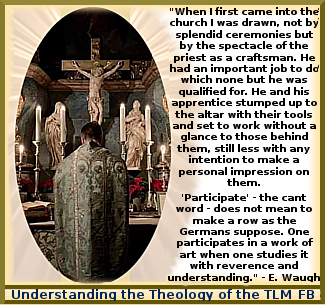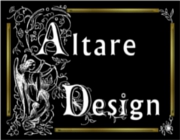An anonymous traditionalist priest, friend of this blog, writes: “The advent of widespread literacy and the production of cheap mass-produced books a century and a half ago made it possible to encourage the faithful to follow the texts of the prayers of the Mass by reading missals of their own. This became the approved norm and the subsequent introduction of microphones in church in order to facilitate ‘active’ participation in the text of the prayers of the Mass radically changed the ethos of liturgical worship.”
Reference the older books on the Mass, such as St. Leonard’s The Hidden Treasure; Cochem’s Explanation of the Holy Sacrifice of the Mass; Gihr’s The Holy Sacrifice of the Mass: Dogmatically, Liturgically and Ascetically Explained, and you will find nothing that even comes close to advocating vocal responses to the priest by the laity as a means of participating. On the contrary, the older books counsel an attitude of recollection, interior participation, and the offering of self together with Christ as another “victim” at the hands of the sacrificing priest. The “dialogue” Mass is actually a subtle attack eroding the role which had traditionally been allotted to the laity: like Mary Magdalen, the laity during Mass were privileged with the better part, the part of silent contemplation. As Ven. Luis M. Martinez puts it, “Something sublime imposes silence.” The stigmatized Saint, Pio of Pietrelcina actually advised that the faithful assist at Mass as did Our Blessed Mother – who stood silently at the foot of the Cross.
 Re: The quote on this graphic. We would caution that the “splendid ceremonies” to which Waugh refers must not be disparaged. It could not have been the intention of Waugh to do so. It appears that he wanted to make the point that priest and laity have entirely different roles and that the laity should not attempt to usurp the clerical duties of neither priest and nor “apprentice” – a word most suited for “altar boy”.
Re: The quote on this graphic. We would caution that the “splendid ceremonies” to which Waugh refers must not be disparaged. It could not have been the intention of Waugh to do so. It appears that he wanted to make the point that priest and laity have entirely different roles and that the laity should not attempt to usurp the clerical duties of neither priest and nor “apprentice” – a word most suited for “altar boy”.
The ceremonies themselves are actions which convey a sequence of mystical events in the re-presentation of Calvary. (See our book.) Understanding this, indeed, makes it possible to penetrate with the heart, mind and soul into the mystical significance of the greatest of miracles transpiring before our eyes.
Father Anonymous continues by saying that in understanding the symbolism of the ceremonies of the Mass, the soul may then, “compose its own meditations according to the response of its heart and thereby be free to contemplate the Sacred Action of Holy Mass…”



